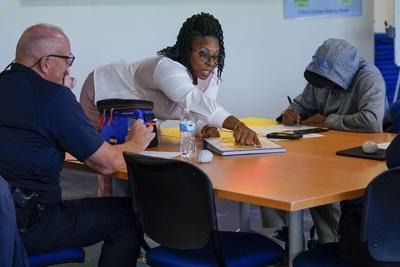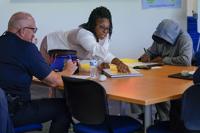BALTIMORE (AP) — A three-minute viral video shows an irate Baltimore police officer berating a teenager because he ignored orders to stop skateboarding and called the officer “dude.”
“Obviously your parents don’t put a foot in your butt quite enough because you don’t understand the meaning of respect,” he shouted at the skateboarder, who remained relatively calm.
That 2007 interaction cost the officer his job. But as policing evolves, others are learning from his mistakes.
The Baltimore Police Department recently started requiring its members to complete a program on emotional regulation that uses video as a learning tool and teaches them the basics of brain science by examining the relationship between thoughts, feelings and actions. It’s a far cry from traditional police training.
In a city whose has long struggled to earn public trust, especially since Freddie Gray’s from spinal injuries sustained in police custody, department leaders are demonstrating their willingness to think outside the box. The approach could become more common as dedicate more resources to addressing mental health challenges among officers and preventing negative public interactions.
Baltimore’s program is overseen by the anti-violence organization , which works primarily with at-risk youth from the city’s poorest and most violent neighborhoods — a population that has more in common with police officers than some might think, according to Roca staff. The organization has provided a curriculum for the eight-hour Rewire4 course, which is now required of all Baltimore police officers. Other law enforcement agencies along the East Coast have also adopted the program, including the Boston Police Department.
“In the streets, we look at some police officers like they’re crazy, and they look at us like we’re crazy,” said James “JT” Timpson, a Baltimore resident who helps lead the Roca Impact Institute. “But we’re both experiencing the same thing, which is trauma.”
Understanding that common ground helps officers relate to members of the public, said Maj. Derek Loeffler, who oversees training and education for the Baltimore Police Department.
Officers in the course were asked to describe some of their most memorable calls for service. One officer recalled a case where three children were found decapitated, comparing the scene to something out of a horror movie. She said the images will haunt her forever.
“It takes a toll,” instructor Lt. Lakishia Tucker told the class. “This stuff ain’t normal that we see, that we deal with, that we handle on a daily basis.”
Police officers are human underneath the uniform, she said, and experiencing repeated trauma can result in hypervigilant behavior.
Instructors played the 2007 viral video as an example of what happens when a person gets triggered and starts operating in survival mode, which they called “bottom brain” because it activates neurological pathways associated with fear and stress responses. The “top brain,” however, is where reason prevails, leading to slower, more careful decision-making.
The training, which was observed by an Associated Press reporter, presented a series of practices rooted in cognitive behavioral therapy, a type of psychotherapy aimed at strengthening healthy neurological pathways in the brain through awareness and repetition. “Flex your thinking” and “Label your feelings” are among the skills presented. Participants can also sign up to receive key lesson reminders via text messages from Roca staff after the training.
The Rewire4 curriculum is a modified version of what the organization’s outreach workers use in their interactions with at-risk youth. Roca, which was founded in Massachusetts over three decades ago, opened an office in Baltimore in 2018. It has since provided hundreds of young men with life-coaching services, job opportunities and behavioral health tools aimed at preventing the rapidly escalating conflicts that so often turn deadly.
Exposing police to similar tools could help reduce police violence, avoid unfavorable headlines and build community trust, organizers said.
“Today is an invitation for you to learn something that can help you personally and professionally,” Tucker told the class of officers. “Law enforcement is different today. Every single thing is being recorded.”
The increased prevalence of body cameras and cellphones means officers are facing more pressure to stay calm even when they get triggered.
During the class, instructors talked about how to avoid a “bottom brain” reaction, in part by approaching others with empathy.
“We have to learn how to separate the person from the behavior,” Tucker said.
That could mean dismantling stereotypes, such as assuming everyone in a certain neighborhood is a drug dealer, said Sgt. Amy Strand, another instructor.
“I like to twist it and say, what about us?” she said, describing how some people assume all police officers are corrupt and aggressive. “We get it dealt to us, so let’s not deal it out to everybody else. Give some grace.”
The Baltimore Police Department recently started administering the training amid a slew of other reform efforts dating back years. In the wake of Gray’s death, Justice Department investigators uncovered a pattern of unconstitutional policing practices, especially against Black residents. That led to a 2017 mandating a series of court-ordered changes.
Soon thereafter, several officers were indicted on federal racketeering charges as the Gun Trace Task Force reverberated through the department, further fracturing public trust. In recent months, the department after two police shootings in adjacent neighborhoods.
Sgt. Maria Velez, the third instructor, said the career brings its challenges, but she still wants to help people. She asked her colleagues to think about their reasons for joining the police force.
“This is more than just a job. You have a calling for this, something inside of you that makes you want to get up every single day and push through adversity,” she said. “Everyone here is still choosing to show up, regardless of what’s happened.”








































